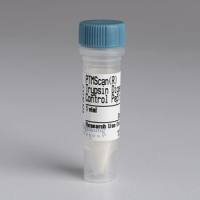Metabolic Labeling with Fatty Acids
互联网
- Abstract
- Table of Contents
- Materials
- Figures
- Literature Cited
Abstract
Covalent attachment of radiolabeled fatty acids (e.g., [3 H]myristate or palmitate) is an alternative method for labeling proteins. This unit contains methods for biosynthetic labeling with fatty acids, analysis of the fatty acid linkage with protein, analysis of total protein?bound fatty acid level in cell extracts, and analysis of the identity of the bound fatty acid.
Table of Contents
- Basic Protocol 1: Biosynthetic Labeling with Fatty Acids
- Basic Protocol 2: Analysis of Fatty Acid Linkage to Protein
- Basic Protocol 3: Analysis of Total Protein‐Bound Fatty Acid Label in Cell Extract
- Basic Protocol 4: Analysis of Fatty Acid Label Identity
- Reagents and Solutions
- Commentary
- Figures
Materials
Basic Protocol 1: Biosynthetic Labeling with Fatty Acids
Materials
Basic Protocol 2: Analysis of Fatty Acid Linkage to Protein
Materials
Basic Protocol 3: Analysis of Total Protein‐Bound Fatty Acid Label in Cell Extract
Materials
Basic Protocol 4: Analysis of Fatty Acid Label Identity
Materials
|
Figures
-
Figure 7.4.1 Fluorogram of thin‐layer chromatography plate showing analysis of acylated nerve growth factor (NGF) receptor.Outside lanes, migration of 0.5 µCi [3 H]palmitate and [3 H]myristate standards. Lane 1, NGF receptor immunoprecipitated from cells labeled with [3 H]palmitic acid. Lane 2, NGF receptor immunoprecipitated from cells labeled with [3 H]myristic acid. Although the cells were labeled with different fatty acids, the protein was labeled with palmitic acid due to chain elongation of [3 H]myristic acid to [3 H]palmitic acid by the cells. Exposure for standards, 1 week; exposure for lanes 1 and 2, 1 month. View Image -
Figure 7.4.2 Structures of myristic and palmitic acids. View Image
Videos
Literature Cited
| Literature Cited | |
| Aitken, A., 1992. Structure determination of acylated proteins. In Lipid Modification of Proteins, A Practical Approach (N.M. Hooper and A.J. Turner, eds.) pp. 63‐88. Oxford University Press, Oxford. | |
| Camp, L.A. and Hoffmann, S.L. 1993. Purification and properties of a palmitoyl‐protein thioesterase that cleaves palmitate from H‐Ras. J. Biol. Chem. 268: 22566‐22574. | |
| DeGrella, R.F. and Light, R.J. 1980. Uptake and metabolism of fatty acids by dispersed adult rat heart myocytes. J. Biol. Chem. 255: 9739‐9745. | |
| Dunphy, J.T. and Linder, H.E. 1998. Signaling functions of protein palmitoylation. Biochim. Biophys. Acta 1436: 245‐261. | |
| French, S.A., Christakis, H., O'Neill, R.R., and Miller, S.P.F. 1994. An assay for myristoyl‐CoA:protein N‐myristoyltransferase activity based on ion‐exchange exclusion of [3H]myristoyl peptide . Anal. Biochem. 220: 115‐121. | |
| Glover, C.J., Goddard, C., and Felsted, R.L. 1988. N‐Myristoylation of p60src. Biochem. J. 250: 485‐491. | |
| Gordon, J.I., Duronio, R.J., Rudnick, D.A., Adams, S.P., and Gokel, G.W. 1991. Protein N‐myristoylation. J. Biol. Chem. 266: 8647‐8650. | |
| James, G. and Olson, E.N. 1989. Identification of a novel fatty acylated protein that partitions between the plasma membrane and cytosol and is deacylated in response to serum and growth factor stimulation. J. Biol. Chem. 264: 20988‐21006. | |
| Jochen, A., Hays, J., Lianos, E., and Hager, S. 1991. Insulin stimulates fatty acid acylation of adipocyte proteins. Biochem. Biophys. Res. Commun. 177: 797‐801. | |
| Kamps, M.P., Buss, J.E., and Sefton, B.M. 1986. Rous sarcoma virus transforming protein lacking myristic acid phosphorylates known polypeptide substrates without inducing transformation. Cell 45: 105‐112. | |
| King, M.J. and Sharma, R.K. 1991. N‐Myristoyl transferase assay using phosphocellulose paper binding. Anal. Biochem. 199: 149‐153. | |
| Magee, A.I., Wootton, J., and de Bony, J. (1995). Optimized methods for detecting radiolabeled lipid‐modified proteins in polyacrylamide gels. Methods in Enzymology 250: 330‐336. | |
| Moench, S.J., Terry, C.E., and Dewey, T.G. 1994a. Fluorescence labeling of the palmitoylation sites of rhodopsin. Biochemistry 33: 5783‐5790. | |
| Moench, S.J., Moreland, J., Stewart, D.H. and Dewey, T.G. 1994b. Fluorescence studies of the location and membrane accessibility of the palmitoylation sites of rhodopsin. Biochemistry 33: 5791‐5796. | |
| Muszbek, L. and Laposata, M. 1993. Myristoylation of proteins in platelets occurs predominantly through thioester linkages. J. Biol. Chem. 268: 8251‐8255. | |
| Newman, C.M.H. and Magee, A.I. 1993. Post‐translational processing of the ras superfamily of small GTP‐binding proteins. Biochim. Biophys. Acta 1155: 79‐96. | |
| Peseckis, S.M., Deichaite, I. and Resh, M.D., 1993. Iodinated fatty acids as probes for myristate processing and function. J. Biol. Chem. 268: 5107‐5114. | |
| Resh, M.D. 1994. Myristoylation and palmitoylation of Src family members: The fats of the matter. Cell 76: 411‐413. | |
| Rodgers, W., Crise, B., and Rose, J.K. 1994. Signals determining protein tyrosine kinase and glycosyl‐phosphatidylinositol‐anchored protein targeting to a glycolipid‐enriched membrane fraction. Mol. Cell. Biol. 14: 5384‐5391. | |
| Rudnick, D.A., McWherter, C.A., Rocque, W.J., Lennon, P.J., Getman, D.P., and Gordon, J.I. 1991. Kinetic and structural evidence for a sequential ordered bi bi mechanism of catalysis by Saccharomycescerevisiae myristoyl‐CoA:protein N‐myristoyltransferase. J. Biol. Chem. 266: 9732‐9739. | |
| Rudnick, D.A., Duronio, R.J., and Gordon, J.I. 1992. Methods for studying myristoyl‐CoA:protein N‐myristoyltransferase. In Lipid Modification of Proteins, A Practical Approach (N.M. Hooper and A.J. Turner, eds.) pp. 37‐61. Oxford University Press, Oxford. | |
| Tomoda, H., Igarashi, K., and Ømura, S. 1987. Inhibition of acyl‐CoA synthetase by triacsins. Biochim. Biophys. Acta 921: 595‐598. | |
| Wedegaertner, P.B., Wilson, P.T., and Bourne, H.B. 1995. Lipid modifications of trimeric G proteins. J. Biol. Chem. 270: 503‐506. | |
| Key Reference | |
| Casey P.J. and Buss J.E. 1995. Lipid modification of proteins. Methods Enzymol. Vol. 250. | |
| A compilation of methods used in studying lipid modification of proteins. |







